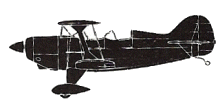
ASN Wikibase Occurrence # 294453
This information is added by users of ASN. Neither ASN nor the Flight Safety Foundation are responsible for the completeness or correctness of this information.
If you feel this information is incomplete or incorrect, you can submit corrected information.
| Date: | Saturday 25 September 2004 |
| Time: | 17:00 LT |
| Type: |  Pitts S-2E |
| Owner/operator: | |
| Registration: | N8005X |
| MSN: | TB-2 |
| Total airframe hrs: | 259 hours |
| Engine model: | Lycoming O-360-A4M |
| Fatalities: | Fatalities: 0 / Occupants: 2 |
| Aircraft damage: | Substantial |
| Category: | Accident |
| Location: | Hanover, Indiana -
 United States of America United States of America
|
| Phase: | Unknown |
| Nature: | Private |
| Departure airport: | Hanover, IN (64I) |
| Dayton, OH (I73) | |
| Investigating agency: | NTSB |
| Confidence Rating: |
The experimental amateur-built aerobatic airplane was substantially damaged when it impacted trees and terrain during an aerobatic maneuver. The pilot reported that they entered a hammerhead [stall maneuver] at 140 - 145 [miles per hour]. The pilot-rated passenger reported that the pilot executed a "sporty" takeoff, followed by a vertical climb. He stated the pilot performed a hammerhead stall and a low-level pass down the runway. The pilot-rated passenger stated that near the end of the runway the pilot once again pulled into a vertical climb, followed by another hammerhead stall. He reported that as the pilot applied power entering the climb the engine hesitated momentarily similar to when the throttle is advanced too quickly. The passenger stated that the aircraft did not have enough altitude to regain airspeed after the stall. Witnesses stated that the accident airplane took off and pulled into a vertical climb. The pilot executed several aerobatic maneuvers including low-level passes over the runway. The witnesses thought the airplane had departed the area when they saw it descend into trees south of the airport. The airport manager, one of the witnesses, stated that the airplane impacted at a 60-degree or more angle and recalled that it was not spinning or turning. The witnesses did not perceive any engine problems. The aircraft impacted a one-lane airport perimeter road south-southeast of the runway. Trees, approximately 25 feet in height, lined both sides of the road. Numerous tree strikes were observed on the tree line south of the road. The aircraft came to rest on the north side of the road, oriented in a southerly direction. A post-accident examination did not reveal any anomalies associated with a pre-impact failure. The operation manual for the accident aircraft stated that the recommended entry speed for a hammerhead stall maneuver was between 130 and 180 miles per hour.
Probable Cause: The pilot's failure to maintain clearance to the trees and terrain during the aerobatic maneuver. Contributing factors were the pilot's decision to perform a low-level, ostentatious aerobatic display and the trees.
Accident investigation:
 |
|
Sources:
NTSB CHI04LA279
Revision history:
| Date/time | Contributor | Updates |
|---|---|---|
| 11-Oct-2022 18:23 | ASN Update Bot | Added |
Corrections or additions? ... Edit this accident description
The Aviation Safety Network is an exclusive service provided by:


 ©2024 Flight Safety Foundation
©2024 Flight Safety Foundation